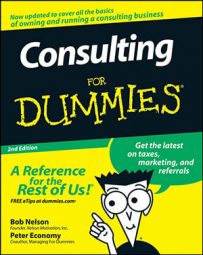A consultant's primary responsibility is to help clients find the best solutions to their needs. This means asking questions and then listening — really listening — to the answers.
The simple fact is that you can't possibly understand what your potential clients need unless you give them the opportunity to tell you. And you can't possibly hear what your client is telling you unless you take the time to listen!
To make sure that you ask clients the right questions and listen to the answers, follow these four steps to effective asking and listening:
1. Ask open-ended questions that define the boundaries of the opportunity.
When you first meet potential clients, you really have no idea what their needs are, how extensive those needs are, and what addressing them will require. Therefore, your first task is to ask the kinds of open-ended questions that help you define the big picture, the rough boundaries of the opportunities it presents, and, thereby, the rough boundaries of your solutions. For example, you might ask, "What results do you want to see from this management training?"
Avoid asking questions that may introduce an element of trepidation into your relationship. Questions along the lines of, "Do you realize how incredibly expensive it's going to be to straighten out this mess?" or "Who's the loser responsible for running this department?" are to be avoided at all costs.
2. Use active silence.
When it comes to listening, silence is golden — not the disinterested silence that comes from having more pressing matters on your mind, but the active silence that tells your clients that you're involved in what they have to say and are interested, thinking, and putting your all into understanding their issues and perspectives.
3. Ask clarifying questions.
Clarifying questions take you from the big picture to the little picture and help you to refine your understanding of your clients' opportunities. For example, asking, "Do you really want a full review of your entire quality assurance system, or do you think that a random sampling of products might accomplish the same goal?" is a good way to help define the extent of the effort required to accomplish a task.
4. Confirm your understandings.
An important part of the process of asking questions and listening to their answers is periodically confirming your understandings with your clients. For example, you might say, "Now here's what I'm hearing that you would like me to do . . ." or "Correct me if I'm wrong, but I believe that what you would like me to do is . . . "
Never forget to listen before you leap! You'll have plenty of time to talk after you land your client. For now, content yourself with asking a few questions to help draw your client out, and listen, listen, and listen some more.

